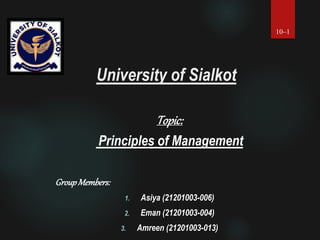
Motivation Theories
- 1. University of Sialkot Topic: Principles of Management GroupMembers: 1. Asiya (21201003-006) 2. Eman (21201003-004) 3. Amreen (21201003-013) 10–1
- 2. MotivationAndIndividualNeeds Motivation: • The willingness to exert high levels of effort to reach organizational goals, conditioned by the effort’s ability to satisfy some individual need Need: • An internal state that makes certain outcomes appear attractive 10–2
- 5. EarlyTheoriesOf Motivation Hierarchyofneedstheory(TheorybyMaslow) there is a hierarchy of five human needs; as each need becomes satisfied, the next need becomes dominant. Physiological: food, drink, shelter Safety: physical safety Social: affiliation with others, affection, friendship Esteem: Internal (self-respect, autonomy, and achievement); external (status, recognition, and attention) Self-actualization: personal growth and fulfillment 10–5
- 7. EarlyTheoriesOf Motivation(cont’d) TheoryX(TheoryMcGregor): The assumption that employees dislike work, are lazy, seek to avoid responsibility, and must be coerced to perform TheoryY: The assumption that employees are creative, seek responsibility, and can exercise self-direction 10–7
- 8. TheoryX Premises A manager who views employees from a Theory X (negative) perspective believes: • Employees inherently dislike work and, whenever possible, will attempt to avoid it • Because employees dislike work, they must be coerced, controlled, or threatened with punishment to achieve desired goals • Employees will shirk responsibilities and seek formal direction whenever possible • Most workers place security above all other factors associated with work and will display little ambition 10–8 EXHIBIT 10.3a
- 9. TheoryY Premises A manager who views employees from a Theory Y (positive) perspective believes: • Employees can view work as being as natural as rest or play • Men and women will exercise self-direction and self-control if they are committed to the objectives • The average person can learn to accept, even seek, responsibility • The ability to make good decisions is widely dispersed throughout the population and is not necessarily the sole province of managers 10–9 EXHIBIT 10.3b
- 10. EarlyTheoriesOf Motivation(cont’d) Motivation-Hygienetheory(Herzberg) Intrinsic factors are related to job satisfaction and extrinsic factors are related to job dissatisfaction Hygienefactors Factors, such as working conditions and salary, that, when adequate, may eliminate job dissatisfaction but do not necessarily increase job satisfaction. Motivators Factors, such as recognition and growth, that increase job satisfaction 10–10
- 13. ContemporaryTheoriesOf Motivation Three-needs theory (McClelland) The needs for achievement, power, and affiliation are major motives in work • Need for achievement (nAch): To achieve something unique (to struggle to achieve success) Moderate risk taker Immediate feedback to work performance Sense of accomplishmentAccording to McClelland's, Achievement oriented people are the backbone of most of the organization of their fast growth. • Need for power (nPow): The need to make others behave in a way that they wouldnot have behaved otherwise. 10–13
- 14. Need for affiliation (nAff): BelongingnessIt is a desire for relationship based on co-operation and mutual understanding. A person is satisfied if he is able to maintain pleasant social relationship.Individual having high affiliation needs perfer working in an environment providing greater personal interaction.Such individuals are effective performance in a team. 10 – 14
- 15. ContemporaryTheoriesOf Motivation(cont’d) Equitytheory(Adams) • Employees perceive what they get from a job situation (outcomes) in relation to what they put into it (inputs) and then compare their input-outcome ratio with the input-outcome ratios of relevant others. 10–15
- 16. ContemporaryTheoriesOf Motivation:EquityTheory (cont’d) Referent • Individual make contribution input and expect certain reward outcome. • They analyze weather exchange is satisfactory or not by comparing their input and output with other. 10–16
- 17. EquityTheoryRelationships 10–17 EXHIBIT 10.6 EMPLOYEE’S ASSESSMENT Inequity (underrewarded) Equity Inequity (over rewarded) *Person A is the employee, and Person B is a relevant other or referent.
- 18. EquityTheory When employees perceive an inequity they may: • Distort either their own or others’ inputs or outcomes. • Behave so as to induce others to change their inputs or outcomes. • Behave so as to change their own inputs or outcomes. • Choose a different comparison referent. • Quit their job. 10–18
- 19. EquityTheoryPrepositions If paid according to time, over rewarded employees will produce more than equitably paid employees. If paid according to quantity of production, over rewarded employees will produce fewer but higher- quality units than equitably paid employees. If paid according to time, under rewarded employees will produce less or poorer-quality output. If paid according to quantity of production, under- rewarded employees will produce a large number of low-quality units in comparison with equitably paid employees. 10–19 EXHIBIT 10.7
- 20. Expectancytheory(Vroom) A comprehensive theory of motivation that an individual tends to act in a certain way, in the expectation that the act will be followed by given outcome, and according to the attractiveness of that outcome to the individual. • The extent to which individuals are motivated to perform to get a reward of value to them is based on their belief that their performance will result in the reward they want. 10–20
- 21. Expectancytheory(Vroom) Emphasizes self interest in the alignment of rewards with employee wants. Addresses why employees view certain outcomes (rewards) as attractive or unattractive. Emphasizes the connections among expected behaviors, rewards, and organizational goals. Is concerned with individual perceptions and the provision of feedback. 10–21
- 22. ExpectancyRelationships(Linkages) Effort–performance • The perceived probability that exerting a given amount of effort will lead to performance Performance–reward • The belief that performing at a particular level will lead to the attainment of a desired outcome Attractiveness • The importance placed on the potential outcome or reward that can be achieved on the job. 10–22
- 23. SimplifiedExpectancyTheory 10–23 EXHIBIT 10.10 Training and development Performance appraisal system Human resources management